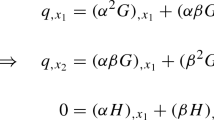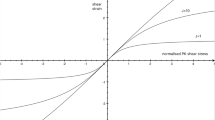Abstract
This paper attempts to clarify the notions of a state of pure shear stress and pure shearing deformations. Specifically, it is shown that pure shearing deformations and pure distortional deformations are not equivalent. Attention is limited to isotropic, compressible, hyperelastic materials. Differences between the distortional deformations of pure shearing, pure shear caused by tension and compression, and plane strain extension and contraction defined as pure shear by Rivlin and Saunders (Philos. Trans. R. Soc. Lond. Ser. A, Math. Phys. Sci. 243(865):251–288, 1951) are discussed. It is shown that these deformations are physically different and should not be expected to test the same features of a proposed form of the strain energy function. It is also shown that two deformations of pure shearing and two deformations of pure shear caused by tension and compression are nearly universal distortional deformations valid for all strain energy functions.





Similar content being viewed by others
Change history
16 June 2021
A Correction to this paper has been published: https://doi.org/10.1007/s10659-021-09838-4
References
Beatty, M.F.: A class of universal relations in isotropic elasticity theory. J. Elast. 17(2), 113–121 (1987)
Bělík, P., Fosdick, R.: The state of pure shear. J. Elast. 52(1), 91–98 (1998)
Boulanger, P., Hayes, M.: On finite shear. Arch. Ration. Mech. Anal. 151(2), 125–185 (2000)
Boulanger, P., Hayes, M.: On pure shear. J. Elast. 77(1), 83–89 (2004)
Cristescu, N.: Dynamic Plasticity. Elsevier, Amsterdam (2012)
Destrade, M., Murphy, J.G., Saccomandi, G.: Simple shear is not so simple. Int. J. Non-Linear Mech. 47(2), 210–214 (2012)
Flory, P.J.: Thermodynamic relations for high elastic materials. Trans. Faraday Soc. 57, 829–838 (1961)
Gurtin, M.E.: The linear theory of elasticity. In: Linear Theories of Elasticity and Thermoelasticity, pp. 1–295. Springer, Berlin (1973)
Hayes, M., Laffey, T.: Pure shear–a footnote. J. Elast. 92(1), 109–113 (2008)
Lode, W.: Versuche über den Einfluß der mittleren Hauptspannung auf das Fließen der Metalle Eisen, Kupfer und Nickel. Z. Phys. 36, 913–939 (1926)
Mihai, L.A., Goriely, A.: Positive or negative Poynting effect? The role of adscititious inequalities in hyperelastic materials. Proc. R. Soc. A, Math. Phys. Eng. Sci. 467(2136), 3633–3646 (2011)
Moon, H., Truesdell, C.: Interpretation of adscititious inequalities through the effects pure shear stress produces upon an isotropie elastic solid. Arch. Ration. Mech. Anal. 55(1), 1–17 (1974)
Norris, A.N.: Pure shear axes and elastic strain energy. Q. J. Mech. Appl. Math. 59(4), 551–561 (2006)
Rivlin, R.S., Saunders, D.W.: Large elastic deformations of isotropic materials VII. Experiments on the deformation of rubber. Philos. Trans. R. Soc. Lond. Ser. A, Math. Phys. Sci. 243(865), 251–288 (1951)
Rubin, M.B.: The significance of pure measures of distortion in nonlinear elasticity with reference to the Poynting problem. J. Elast. 20(1), 53–64 (1988)
Rubin, M.B.: Simple, convenient isotropic failure surface. J. Eng. Mech. 117(2), 348–369 (1991)
Rubin, M.B.: Plasticity theory formulated in terms of physically based microstructural variables – part I. Theory. Int. J. Solids Struct. 31, 2615–2634 (1994)
Sacommandi, G.: Universal results in finite elasticity. In: Yu, Y.B., Ogden, R.W. (eds.) Nonlinear Elasticity: Theory and Applications, p. 283 (2001). Chap. 3
Thiel, C., Voss, J., Martin, R.J., Neff, P.: Shear, pure and simple. Int. J. Non-Linear Mech. 112, 57–72 (2019)
Ting, T.: Further study on pure shear. J. Elast. 83(1), 95–104 (2006)
Acknowledgements
The author would like to thank the reviewers for suggesting additional relevant papers and acknowledge helpful discussions with K Heiduschke.
Author information
Authors and Affiliations
Corresponding author
Additional information
Publisher’s Note
Springer Nature remains neutral with regard to jurisdictional claims in published maps and institutional affiliations.
Rights and permissions
About this article
Cite this article
Rubin, M.B. Pure Shearing and Pure Distortional Deformations Are Not Equivalent. J Elast 142, 383–393 (2020). https://doi.org/10.1007/s10659-020-09798-1
Received:
Accepted:
Published:
Issue Date:
DOI: https://doi.org/10.1007/s10659-020-09798-1
Keywords
- Finite deformation
- Isotropic hyperelasticity
- Pure distortional deformation
- Pure shearing deformation
- Nearly universal distortional deformations




